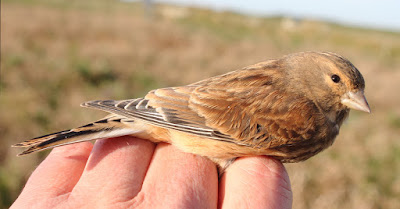What a great outcome from Linnet ring number Z722984. It was aged and sexed as a first year male and caught at our set-aside plot near Pilling on 24th October 2016. Even better news was the fact that Z722984 was ringed as a nestling, one of a brood of six, but many miles from Pilling.
Linnet
We found out via the BTO that the young Linnet was ringed by members of Shetland Ringing Group at Scousburgh, Shetland 674 kms from Pilling on 14th June 2016. Shetland, also known as the Shetland Islands, is a subarctic archipelago that lies about 150 miles northeast of Great Britain and approximately 200 miles west of Norway.
Linnet, Shetland to Pilling
The BTO Breeding Atlas for 1989-1991 suggests that Linnets do not breed in Shetland, a landscape where Linnets are often replaced by the closely related Twite, a species known colloquially as the “mountain linnet.” However from the 1990s the Linnet made a small comeback on Shetland with the BTO Bird Atlas for 2007-2011 showing extra dots on the map where Linnets now breed on the mainland but where overall they are still hugely outnumbered by Twite.
Linnet
Ringing birds in the nest provides information not generally obtained from ringing fully grown birds. Many ringers participate in the Nest Record Scheme (NRS) to provide data on nesting success and the ringing of nestlings. The data gathered shows trends on both nesting success and breeding failure when a nest fails at egg or fledging stage and the reason, e.g. predation, desertion, weather, etc.
Where a nest is successful ringing chicks in the nest goes on to provide a life history through the exact age of the bird, the place of birth and the number of siblings. Any subsequent recovery of ringed nestling, as in the case of Z722984 gives an ever more complete picture of an individual’s life. And of course Linnet Z722984 remains in circulation to potentially provide another piece in the jigsaw.
Linnet nest- via Wiki
The most recent summary of BTO ringing totals for UK and Ireland in 2015 show that of 8,722 Linnets ringed during that year, just 556 were nestlings. This equates to approximately 100 nests only.
We will continue our visits with aim of collecting more information as current data from BTO ringing of Linnets mainly reflect lowland English populations between April and October. Populations in Ireland, Wales, south west and north west England, and south west Scotland are underrepresented with 14% only ringed as nestlings and just 11% ringed during the winter months.
Linnet
The weather this week has been poor for both ringing and birding with a couple of visits to the set aside suggesting that our Linnet flock is much reduced. A couple of counts have seen as few as a dozen Linnets or up to forty five in attendance, and nowhere near the 200/300 of October. As a partial migrant it could be that many Linnets present in recent weeks have moved on, but a spell of cold weather might bring an influx of birds from elsewhere.
Linking today to Anni's Birding Blog.
Linking today to Anni's Birding Blog.








































.jpeg)






.jpg)












